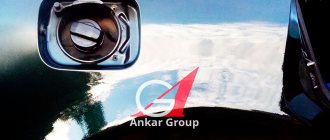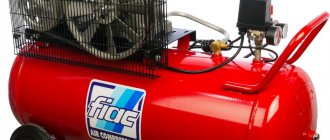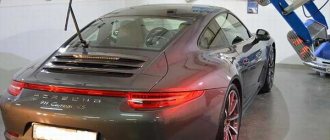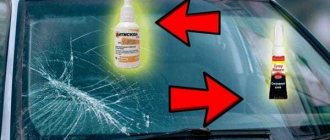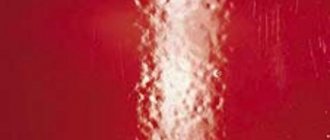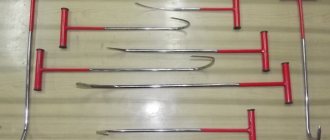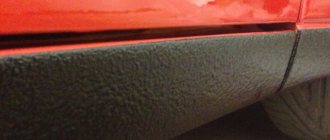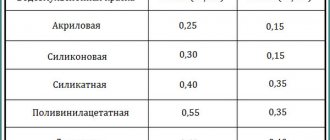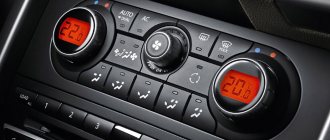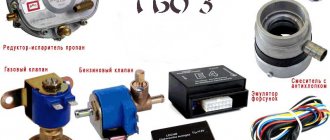Professionals involved in car painting work have the opportunity to choose a set of tools, focusing on the most frequently encountered tasks, their own habits and work experience. A beginner does not have this opportunity. He needs to immediately buy a spray gun for painting a car, capable of solving a certain range of problems due to its features. Whether it will be a budget or professional device, pneumatic or electric - knowledge about the models, types and varieties of devices offered today will allow you to decide.
How to choose a successful model suitable for solving a given problem
Choosing a spray gun that will immediately perfectly meet your needs and bring pleasure when working with it is almost impossible. The problem is that a beginner often does not fully know all the intricacies of the painting process and cannot clearly formulate a list of requirements for the tool. However, there are several basic criteria by which one or another automobile spray gun is assessed for the overall level of reliability and convenience.
Reliable materials are the key to durability
When choosing a spray gun for painting a car or for other purposes, you should not neglect a thorough analysis of the materials from which it is made. It is worth considering all the details before purchasing.
- The body of a good atomizer is necessarily made of aluminum. For models with increased reliability, structural elements are plated with nickel to protect against corrosion. You should not consider models whose body is made of silumin or other alloys that do not have high mechanical strength and resistance to acidic and alkaline environments.
- The design part that experiences the maximum wear is the paint ejection nozzle. The minimum requirement that a model acceptable for long service must meet is the manufacture of this element from aluminum. If you need a truly reliable tool, you should opt for a spray gun with a brass or stainless steel nozzle.
In general, the entire structure should be as light as possible, made of aluminum and steel, with a good trigger trigger, which should also be made of metal. Saving every gram is a smart move.
Important! It is worth remembering that the total weight of the tool will increase significantly when the working mixture is poured into the colorful glass.
Another area of careful evaluation is the degree of sealing. A car spray gun, regardless of its class, works with high pressure. Liquids must not leak. Therefore, special attention is paid to the quality of gaskets and seals. A good spray gun will offer reliable elements made of fluoroplastic and technopolymers. High quality models are equipped with Teflon gaskets.
Location and capacity of the paint tank
Today, the choice of spray gun for painting a car is offered among models with an upper or lower location of the paint tank. Both types of devices have their own usage characteristics.
- A spray gun with an overhead tank is capable of working with high-viscosity paints; it requires maintaining a constant orientation of the tool for a stable supply of the mixture. The main feature of working with such models is that it is advisable to produce the entire volume of the glass. Changing it is a fairly long process, so you won’t be able to quickly switch from one paint to another.
- Spray guns with a bottom tank will offer a quick change of paint. These models use a siphon paint supply method. This imposes some restrictions on the level of its viscosity, however, experienced painters appreciate the convenience of changing the glass almost without stopping the painting process.
Models with an upper and lower tank differ in weight distribution, ease of operation, and visibility of the surface to be painted. Beginners value simplicity first. They prefer to buy a spray gun with a lower cup for painting a car. This model will allow you to quickly change paints; it offers maximum visibility of the painting area and accessibility of all adjustment controls.
Available adjustments
The configuration of the torch spot and the consumption of the color mixture are responsible for the overall performance. Therefore, a good spray gun must have at least two adjustments:
- adjusting the torch, in the normal position the paint spot has a round shape, by adjusting it achieves a vertically elongated ellipse;
- changing the needle position.
A professional tool often differs from the average spray gun for beginners. In particular, it has a longer needle stroke, the ability to limit its movement and fix its position. It is also often possible to fine-tune and conveniently adjust the size of the torch spot.
Spray gun device
Spray guns for applying paints have the following main parts:
- frame;
- container for sprayed material;
- paint supply mechanism;
- spray pattern regulator;
- outlet pressure regulator;
- a trigger that opens the supply of air and material;
- needle that regulates the amount of material;
- spray head with air channels;
- nozzle or nozzle of a certain diameter;
- Air hose connection connector.
The spray head and internal nozzle are considered the most expensive parts; the quality of atomization depends on them.
Specifications
The list of works that can be performed with high efficiency directly depends on the characteristics of the spray gun. Also, the marking of the device can say a lot about the mechanics of using the tool, the efficiency of mixture consumption, and the ease of operations in confined spaces.
Nozzle diameter
The diameter of the nozzle allows you to select a device based on both the types of dyes used and future work.
- Base coats, such as metallic or solid paint, are best applied with a spray gun with a 1.2 to 1.3 mm nozzle.
- For working with varnish and acrylic paints, including finishing work, it is recommended to choose a tool with a nozzle from 1.4 to 1.5 mm.
- It is better to apply primers with a sufficiently large grain size of the working mixture (including acrylic type 2K) through a nozzle from 1.5 to 1.7 mm.
- When using putties, it is recommended to use a nozzle from 1.7 to 2.0 mm.
As experience grows and tasks with specific requirements appear, the master begins to study the technical data of paints and select the diameter of the spray gun nozzle. However, there is an easier route available for beginners. A nozzle diameter of 1.4 mm is considered to be quite universal, suitable for solving a wide range of problems. This tool can be used to work with almost all paints; with some restrictions, priming operations can be carried out. When using thick mixtures, they are diluted with a solvent, selecting the consistency experimentally.
Advice! The best strategy would be to purchase a spray gun that comes with interchangeable nozzles with different nozzle diameters.
Differences between spray guns in terms of operating pressure and efficiency of use
The mechanics of operation of a pneumatic spray gun are quite simple. Air under pressure is mixed with the dye and ejected in the form of a torch through a nozzle. There are two key parameters considered here. The actual inlet pressure, parameters of the ejected mixture, paint consumption and the efficiency of its use. There are several standard classes of devices on the market today. Types of spray guns are marked:
- HP - high pressure;
- HVLP - high flow, low pressure;
- LVLP - low flow, low pressure;
- RP - with a decrease in pressure in the mixing chamber.
Other markings and types of spray guns are, in a sense, derivatives - they combine the properties and features of the listed classes. Such devices will be of interest to professionals for performing work with specific requirements. In particular, the market offers LVMP (low flow medium pressure), MP (medium pressure), HTE (high paint efficiency) class models.
The HP system is considered a classic. People who are guided by the opinion of, so to speak, older painters decide to buy just such a spray gun for painting a car. Such specialists are accustomed to an instrument of this class and do not pay attention to its shortcomings.
Pneumatic spray gun Wester FPG10-PL HP 55184
The HP system has a nice feature in the form of a wide spray pattern. This tool makes it easy to apply even, thin layers of paint over a large area. High labor productivity is ensured. But the average hobbyist should pay attention to the main drawback: the paint sprayed under high pressure in the HP system creates a large cloud, the so-called spray . The working mixture simply flies into space, coloring everything around. As a result, using an HP system in a small area is economically ineffective - a huge percentage of paint is wasted.
The HVLP system is more interesting for beginners. Such spray guns eject the mixture under a pressure of about 0.7 atm, requiring an input of about 2.5-3 atm. The operation of the system is characterized by extremely small particles of paint, a focused torch, and a low percentage of spray. Not only high labor productivity is ensured, but also good economic efficiency indicators. HVLP spray guns apply a minimum of 65% paint to the target surface.
Pneumatic spray gun KRAFTOOL AirKraft, HVLP
But the most attractive for beginners is the LVLP system. Such devices are ideal in everything:
- provide a neat torch;
- characterized by minimal spray;
- apply at least 65% paint to the target surface;
- require relatively modest compressor performance;
- react little to pulsation and changes in inlet pressure.
Important! Another attractive feature of the low pressure LVLP system is its ability to work in hard to reach areas. Low flow rate in combination with a neat torch allows you to increase the distance from the tip of the nozzle to the target surface by 50-100 mm.
Spray gun LVLP Huberth R500 (nozzle 1.3-1.4-1.7 mm)
The RP system can be considered universal for an undemanding consumer. Spray guns of this type work with most varnishes, paints, primers, provide a wide spray pattern, good performance and quality of paint application. Tools of this class have average requirements for a compressor; they can achieve excellent results when processing large areas.
Nozzle size selection
The nozzle for paint exit (nozzle) also has a certain size. The paint material flows through a nozzle into which a needle is inserted to regulate the flow of paint. With the help of a needle that moves forward/backward, the pressure is adjusted: when the needle is completely lowered, the nozzle is hermetically closed by a pressed spring. Depending on the viscosity of the materials, the size of the nozzle diameter will change. Based on the nozzle diameter and settings, spray guns are divided into the following groups:
- 1.1 — Regular painting;
- 1.2 - 1.5 - Application of varnish or base, and also used for painting with water-soluble varnishes;
- 1.3 - 1.7 - Application of acrylic or varnish;
- 1.5−2.1 - priming;
- 2.6−3.1 - applying liquid putty.
These are approximate general rules that must be followed. Many painters choose one size for the nozzle and are quite capable of painting with any materials.
It is also useful to read: Is it worth painting a car with an electric spray gun?
There are some limitations, for example, applying primer requires a large nozzle size, otherwise the primer will need to be diluted very thinly. Acrylic varnish is important for its filling ability, so it is not advisable to dilute it, and in its undiluted form you will need a nozzle with a cross-section of 3.0 units.
These are general rules that do not have to be strictly followed. Some painters choose one nozzle size and apply any materials perfectly. To use water-soluble paints, use a separate gun.
Important! When replacing water-soluble paint with enamel, the material may curl and spray will occur with flakes. And also, after using water-soluble paint, you need to be sure that the spray gun is clean and dry after use, this will save it from rust.
Compressor requirements
Beginners often make one common mistake. Having a pneumatic compressor in the garage or workshop, they believe that its characteristics will be sufficient for any spray gun. In practice this is not the case. Each device of a certain class puts forward its own requirements for the supercharger.
- The HP system will require up to 5 atm of input pressure and a capacity of up to 300 liters of air per minute.
- For HVLP, the compressor must produce 3 atm at an air flow of 360 or more liters per minute. In this case, it is recommended to equip the devices with moisture and oil filters, since the supercharger has to work almost at the limit of its capabilities and continuously.
- The LVLP system will require up to 2 atm at the inlet and pumping at 150-350 liters per minute.
In order not to make a mistake in choosing and not to encounter troubles, it is recommended that before going to the store you find out the exact characteristics of the compressor you already have in stock. Or buy a complete set of equipment. There is another option: electric spray guns are quite popular among beginners.
Spray systems
The operating principle of this equipment is the same. The device mixes the dye in a tank (or another solution). Compressed air under the compressor enters the device. The solution flows through another channel. The air splits the mixture coming out of the nozzle, forming a solution torch. Then the liquid medium is supplied in the form of a fine-grained jet to the car body part. Depending on the pressure force and the mixture supply scheme, the type of equipment is determined. There are the following spraying options by which these devices are classified:
- HP;
- HVLP;
- LVLP.
To choose the optimal specimen for painting, you need to have information about each of the systems. We will talk about three popular options.
Spray systems
HP system
Produces a working pressure of 3-4 atmospheres. Creates a wide torch and evenly applies paintwork to the surface. The speed of application of the mixture is high. The model is relatively inexpensive. The disadvantages of the unit include:
- low coefficient of transfer of liquid substance to the surface;
- significant air movement provokes the raising of dust in the workshop, which is undesirable;
- The system is quite old, but reliable.
After using this type of spray gun, the surface of the car is sanded. This is due to the high rate of air contamination with dust.
HVLP system
This type of equipment has been used since the 90s. twentieth century and has proven itself well. The device uses a significant volume of air, and the mixture is sprayed at low pressure - one atmosphere. Thanks to this technology, over 75% of the paintwork material is transferred to the working surface. The system has its advantages:
- creates a low level of fog in the air;
- does not raise dust in the workshop;
- shows good performance.
Pay attention to: How to choose paint by VIN number - search and determine the enamel code
There are several disadvantages to this system. It requires a powerful compressor to operate. The coloring solution should be applied close to the surface. This makes it difficult to process hard-to-reach, remote areas. The procedure will require special skills.
LVLP system
This type of sprayer is an innovative device, and was developed to eliminate the shortcomings of the previous two types of units. The technology used makes it possible to combine low air consumption with a significant coefficient of paint coating application. The input pressure of these devices is 1.6-2 atm, and the spraying process is 0.7-1.2 atm. The efficiency of the mixture transferred to the surface is 70%. The unit distributes any liquids. Paint guns of this brand:
- do not consume a lot of air;
- have a high percentage of efficiency;
- do not raise dust;
- create minimal “fog”;
- do not respond to power surges;
- show an excellent percentage of spray paint.
This type of equipment has few disadvantages: it creates a smaller torch than the previous two types and a low solution spraying speed. The LVLP spray gun has proven itself well during operation.
Electric spray guns for painting cars
An electric spray gun is a fairly new device on the market. This is a fully balanced, often automatic complex. For it to work, you only need access to the power supply. All the necessary equipment (compressor, spray handle, paint cup) is arranged in fairly compact units.
Until recently, the main disadvantage of an electric spray gun was its large weight and poor ease of use. But today models are being produced that cause virtually no inconvenience. The ideal option for a beginner is an electric spray gun, the compressor unit of which is hung on backpack unloading straps behind the operator’s back (or on the shoulder).
Some models require installation of the supercharger on the floor.
Even more inconvenient ones suggest holding the compressor unit in your hands.
A modern electric spray gun offers a number of convenient features:
- long continuous operation thanks to the use of a membrane compressor;
- high performance of models with a piston compressor;
- high overall reliability and durability;
- variety of assortment of paints, varnishes, primers used;
- high productivity.
In addition, an electric spray gun allows you to not fully use the working mixture and quickly change containers. You need to choose such a device based on the diameter of the nozzle, available adjustments and the nature of paint consumption. In general, a tool of this class does not offer high flexibility and versatility, but it allows you to perform the necessary operations efficiently using one device without complex settings.
What is a spray gun
This equipment is designed for automatic painting of various (metal, wood, plastic, stone) surfaces and has universal characteristics. It is possible to adjust the operation of the tool, depending on the task. The device allows you to “evenly” apply a paint coating, forming a smooth layer, without fluff, pellets, or bristles, which are possible when working with a roller. The device consists of three main technical components:
- spray gun;
- paint storage tank;
- power supply systems for supplying the mixture.
Today, several types of equipment are produced for carrying out paint and varnish activities. The operating principle of all these units is approximately the same. In addition, using this automatic device, it is possible to apply paintwork not only to vehicle bodies. It is also used for:
- applying a decorative protective coating to a metal surface;
- spraying trees, shrubs, flowers in the country;
- treating premises against insects;
- surface priming during repair and construction operations;
- sanitary disinfection (from fungi) of rooms, workshops, apartments, private houses;
- processing of road infrastructure objects.
A pneumatic spray gun sprays any type of solution. The main thing is that individual fractions of liquid pass through the hole without problems. In this case, the viscosity of the mixture must correspond to the required technical parameters.
Diagram of the spray gun device
How many spray guns should you have?
There are units designed for applying paint, primer, and varnish. The best option would be to have three spray guns at hand. Each of the devices will perform its own “role”, spraying one or another type of liquid. This eliminates the risk of mixing varnish with primer or paint when using one device. It is possible to use one device for all types of solutions. But then you will have to additionally carry out the procedure of washing the equipment before pouring different mixtures. Next, we will tell you how to choose a spray gun for painting a car.
Please note: Painting a car with chameleon paint
A tutorial for beginners: how to paint a car with your own hands
It is better to paint the car in a well-lit place, if this happens in the garage - dust, cobwebs, and dirt should not fall on the car. The stages of preparation for painting look like this.
- The body is thoroughly washed, all dust, traces of bitumen and grease are removed. Only special solvents or White Spirit should be used.
- Bumpers, lighting equipment, decorative elements, wheel protection in arches and other parts that cannot be painted are dismantled.
- The condition of the coating is being studied. All defects (chips, cracks) are marked with chalk or acrylic paint.
- In the marked areas, the paint is knocked down to the metal with a screwdriver, the areas are sanded with sandpaper with a grain size of 60-80, achieving a smooth transition into an intact paint surface.
- Defective areas are puttied. To do this, a finishing mixture is used; it must be smoothed, achieving a flat surface that protrudes as little as possible above the intact paint.
- After the putty has dried (according to the manufacturer's instructions), sanding is done with sandpaper from 120 to 600, ideally leveling the defect area with the surface of undamaged paint.
Important! At the final stage of grinding, if the performer is too eager, an additional layer of putty may be necessary to level the surface.
Before painting, you should protect any unnecessary areas with masking tape, newspaper or film. The entire surface of the body is evenly sanded with 1200 grain until matte. After this, dust is removed, wiped with White Spirit, followed by drying. The car is ready for painting.
- The enamel of the desired color should be diluted. The mixture is thoroughly mixed. By adding a solvent, the following result is achieved: after dipping the metal rod 1-2 mm and removing it, the paint should drain at a speed of 3-4 drops per second. After this, the paint is poured through a filter (for example, a piece of nylon stocking) into the spray gun container.
- In most cases, it is recommended to work with a 1.4 mm nozzle at a spray inlet pressure of up to 3 atm. Before applying paint to the car, you should make sure that the spray is even and adjust the spray pattern. Setting up the spray gun for painting a car is done on an unnecessary surface. After this, coloring is done.
- Paint your car correctly - starting from the roof. The gun should be held so that there is 120-250 mm from the nozzle to the surface of the body. You need to apply paint in motion, turning on the feed when the sprayer moves and stopping it before reaching the final point of the trajectory.
- The paint on the car must be applied in 2-3 layers, the pre-drying interval between them is from 15 to 20 minutes. This is the only way to achieve a uniform, rich and authentic color when working with your own hands. After painting is completed, the car is left in a warm, moderately ventilated room with a temperature of at least 20 degrees Celsius for 1-1.5 days.
Upon completion of the drying process, remove protective films, newspapers, and masking tape. The paint-filled points of the screw connections are carefully cut through with taps and dies. After this, they install all previously removed equipment in their original places and enjoy the updated look of the car.
Let's sum it up
You can do a lot of car coating work yourself. If you really want, you can purchase and use painting equipment in your own garage. You can only finish a car well if you have everything you need for this process. Often, the first time it is not possible to create a really high-quality layer of paintwork, and this depends not on the quality of the devices, but on the experience of the master.
There is an opinion that a good specialist with significant experience can paint a car even with the cheapest spray gun. This is impossible, since the quality of the paint spray determines the actual characteristics of the finishing layer. If you pay attention to the work of expensive craftsmen, for them the ability to choose professional devices is one of the most important parameters for achieving a good result. So pay special attention to this condition of the spray booth.
